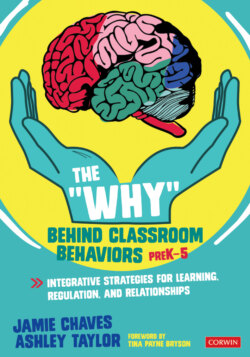Читать книгу The "Why" Behind Classroom Behaviors, PreK-5 - Jamie Chaves - Страница 16
На сайте Литреса книга снята с продажи.
Strategy 2: Reflect Often
ОглавлениеReflection helps cement learning.11 One of the exciting things about life and our brains is that there is no end to self-discovery. Because of this, we will provide opportunities throughout the book for you to integrate the left and right side of your brain by understanding this information in a logical way and also having the opportunity to reflect and “feel” the information on a more experiential level. The “reflective activities” in each chapter will help you, as teachers, to consider various aspects about yourself and your teaching approach in order to better connect with your students’ experiences and enhance your ability to utilize the information in this book.
In his books, Dr. Dan Siegel talks about the foundational importance of COAL: curiosity, openness, acceptance, and love.3,10 We hope to foster this tone throughout our book, as well as provide opportunities for us to use this as a starting point to allow a safe place to reflect together. Here are some questions that you can use to reflect about yourself as you get started. You can keep these questions in mind as you continue to read.
What can I do to regulate myself throughout the day?
What are signs of dysregulation that I notice in myself?
How can I create patterns of empathy, understanding, and trust with even the most challenging students?
Who can I talk to or be with in order to process the events of my day or week?
What areas of teaching are restorative and which areas are draining? Why?
Which of my personal relationships are restorative and/or draining, and how do they impact my teaching?
Next, consider these questions regarding your students. Again, keep these questions in mind as you continue to read this book.
Why might this student be demonstrating this behavior?
Are there patterns of dysregulation that I notice in this student?
How can I come alongside and join with, rather than penalize the student?
What can I do to help this child co-regulate in this moment?
Is there something I am doing that is contributing to a cycle of co-dysregulation?
Am I making false assumptions about this student’s behavior?
What are the strengths of this student, and how can I capture those strengths?
With which students do I need to build stronger relationships?
Not only is it important to use the brain to help our students develop integration, but it is also important to remember how to use the power of the mind in moments of stress and dysregulation. As we get to know ourselves better, and reflect more often, this will help us to have more integration in our brains and our lives. We will then be better able to maintain a regulated stance when confronted with overwhelming situations. Once this happens, we will be better able to use a right hemisphere to right hemisphere connection 11 between teachers and students to portray a regulated, safe, meaningful message of connection and comfort to the other person.6,11 This means connecting emotionally, using mostly nonverbal communication. We will discuss how to do this in moments throughout the book, especially when we talk about attending to our nonverbals. This type of “right to right” connection between people, if done correctly, can help to develop a powerful, protective relationship or “teacher-student dyad,” between a teacher and the students in her class.
